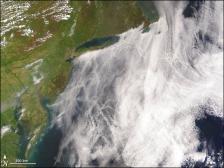4) Climate varies over space and time through both natural and human processes.
 A satellite image shows the tracks in the atmosphere and ocean left by ships sailing across the Atlantic.
A satellite image shows the tracks in the atmosphere and ocean left by ships sailing across the Atlantic.The fourth principle recognizes that climate is neither uniform nor unchanging. Some variations occur slowly on a global scale: the eccentricity of the Earth’s orbit around the Sun contributes to a discernible 100,000-year cycle of variation in climate, while the movement of continents due to plate tectonics influences climate over millions of years. Climate also can change abruptly, as it did during a phase toward the end of the last Ice Age known as the Younger Dryas, with an increase of 10°C (18°F) occurring in Greenland about 11,500 years ago over a period of mere decades.
Those changes were due to natural processes. But humans also can change climate on regional scales, by altering land cover through agriculture or building large urban complexes, and on global scales, primarily through the burning of fossil fuels and the resulting release of heat-trapping carbon dioxide (which is the focus of Essential Principle Six).
CLEAN’s “Teaching Essential Principle 4” provides overview of the content, why it is important, related pedagogical challenges, and examples of high quality resources by grade level.
Continue to the next section to find out how our understanding of the climate system is improved through observations, theoretical studies, and modeling.
